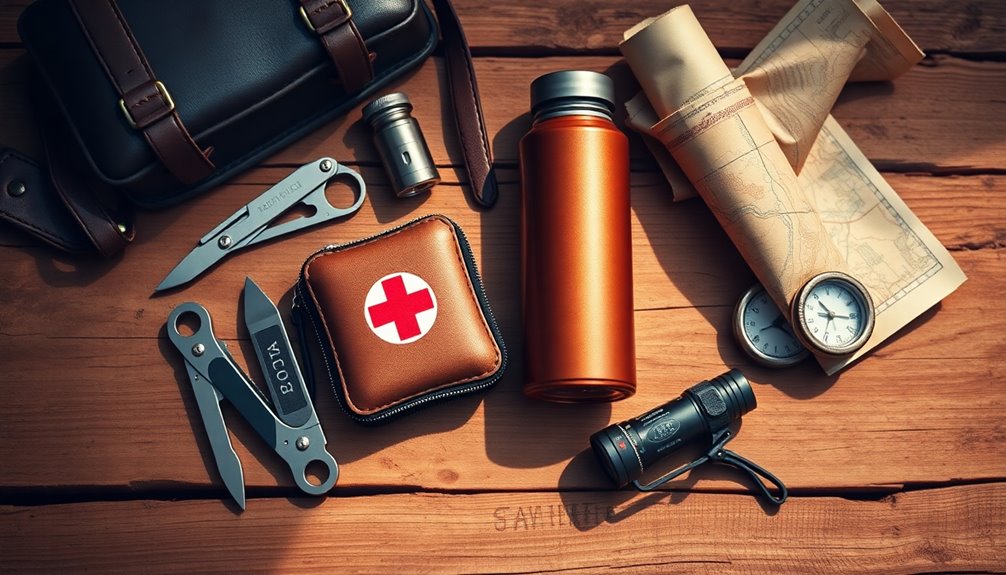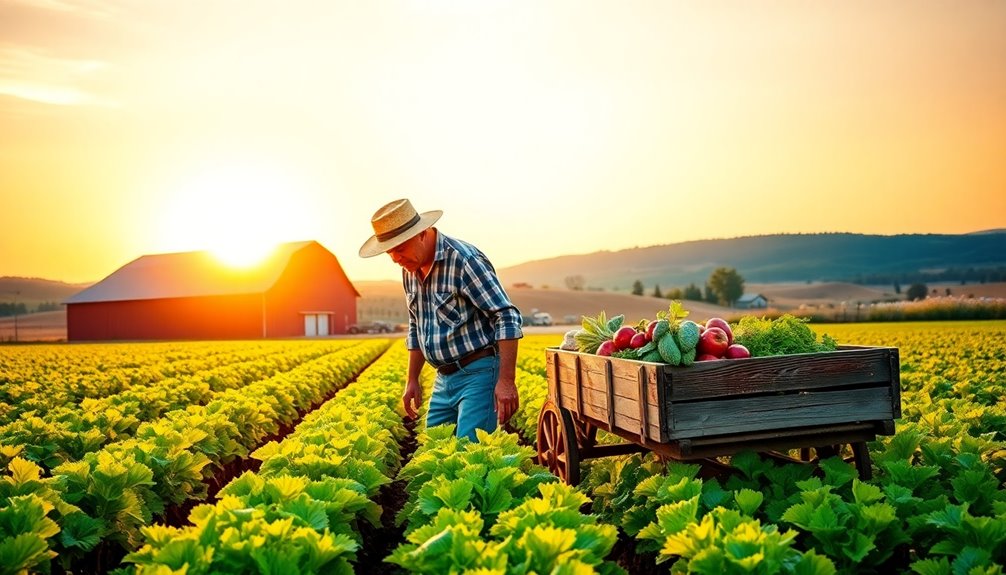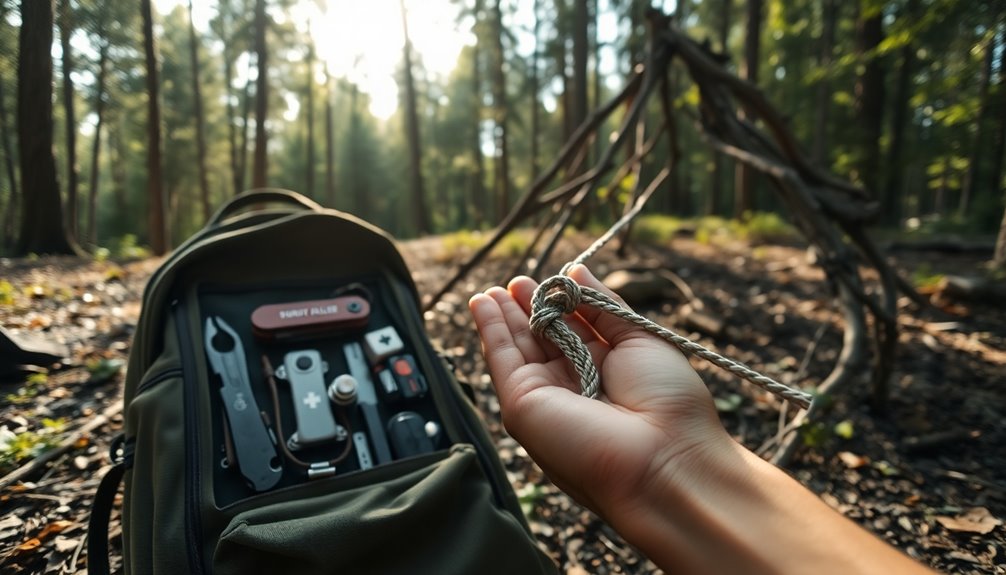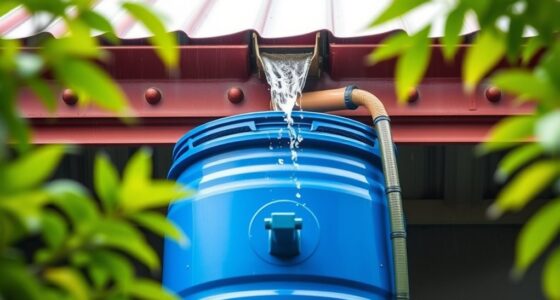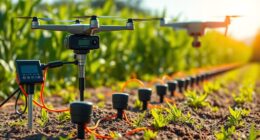When you're heading out, don't forget your survival essentials. Start with enough non-perishable food and water for at least 72 hours. Pack a comprehensive first aid kit, fire-starting tools, and navigation tools like a compass. Maintaining your kit is vital, so inspect supplies every six months and rotate perishables. Consider seasonal adjustments like warm clothing in winter or insect repellent in summer. Keep your gear organized for quick access, and ensure it's stored in a convenient location. You'll be better prepared when emergencies strike, and there's much more to discover about optimizing your survival strategy.
Key Takeaways
- Always pack enough non-perishable food and water for at least 72 hours to sustain yourself in emergencies.
- Include a comprehensive first aid kit with necessary medical supplies and medications for prompt treatment.
- Equip your kit with fire-starting tools, like waterproof matches, for warmth and cooking needs.
- Use navigation tools, such as a compass and maps, to enhance your chances of finding help when lost.
- Regularly inspect and rotate supplies to ensure freshness and effectiveness, especially for food and medications.
Introduction
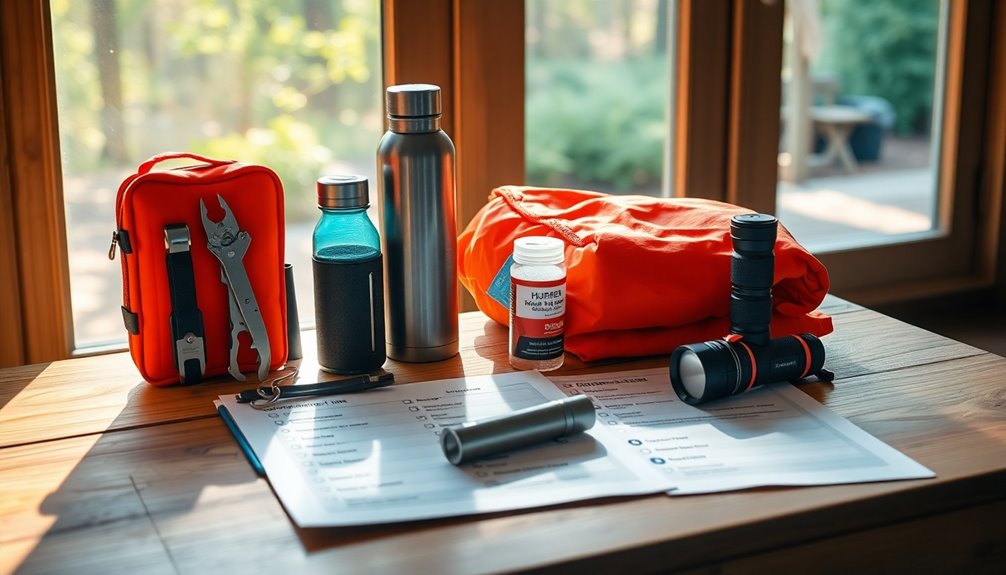
When you head out on any journey, having a survival checklist is crucial to ensure you're prepared for emergencies.
By including essential items like food, water, and first aid supplies, you can significantly improve your chances of staying safe.
Let's explore the rationale behind emergency preparedness and the must-have items you shouldn't overlook.
Essential Items for Emergencies
Preparedness is crucial in any emergency situation, and having the right essential items can make all the difference.
Start by packing an emergency kit that contains enough water and food to last at least 72 hours. Non-perishable items like protein bars, trail mix, and canned goods are vital for sustenance.
Don't forget a comprehensive first aid kit with bandages, antiseptics, and pain relief medication to address injuries or medical issues. Including sanitation supplies like toilet paper and hand sanitizer is essential for maintaining hygiene.
Additionally, a survival kit should have tools such as a flashlight, multi-tool, and emergency blankets to enhance your readiness for unexpected situations.
These essential supplies can ensure your safety and wellbeing during emergencies.
Emergency Preparedness Rationale
In the face of unexpected crises, having a solid emergency preparedness plan can be your lifeline. Nearly 48% of Americans lack adequate emergency supplies, leaving them vulnerable in a survival situation.
A well-stocked emergency kit, including essential items like food items and water purification tools, can sustain you for at least 72 hours. Regularly checking and rotating supplies ensures freshness, so you're always ready. Preparedness not only reduces panic but also boosts your confidence, allowing you to respond effectively during breakdowns.
A bug out bag checklist should be a priority for everyone, especially those in high-risk areas. Understanding the importance of emergency preparedness can significantly enhance your survival chances, making it vital to act now.
Survival Kit Essentials Overview
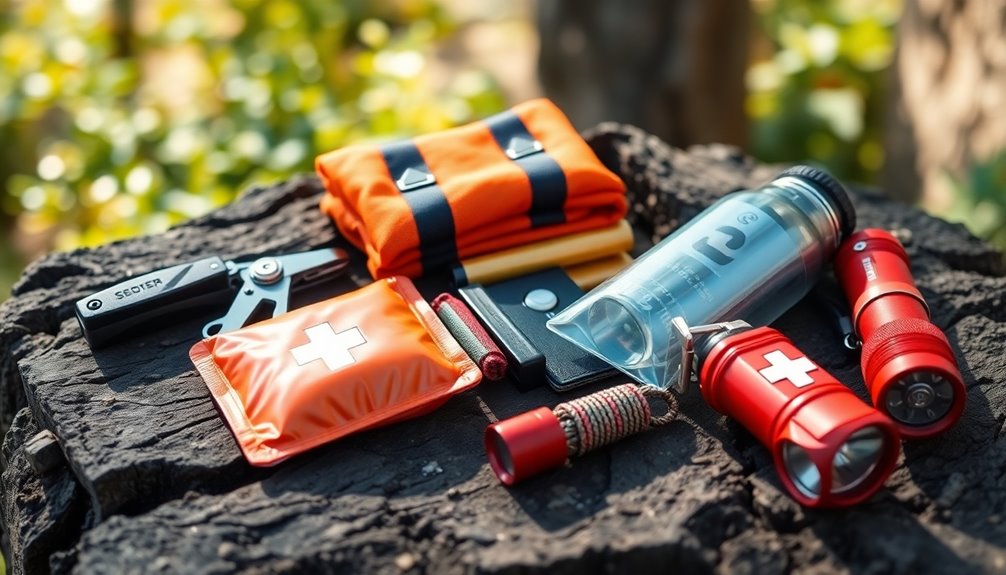
A well-equipped survival kit is crucial for navigating emergencies, ensuring you meet your basic needs. Your survival gear should include essential items categorized by the Survival Rule of 3s: air, shelter, water, and food.
It's important to keep a versatile knife and fire starter for various tasks. Don't forget a durable water bottle and purification tablets to access a clean water source.
For health and safety, a comprehensive first aid kit is a must, along with hygiene supplies like hand sanitizer.
Make sure you pack at least three days' worth of non-perishable food, such as protein bars and MREs, to sustain your energy levels. Additionally, consider including a multi-functional tool to maximize your kit's efficiency in various situations.
Regularly review and update your kit to keep everything functional and suitable for changing conditions.
Critical for Unexpected Emergencies
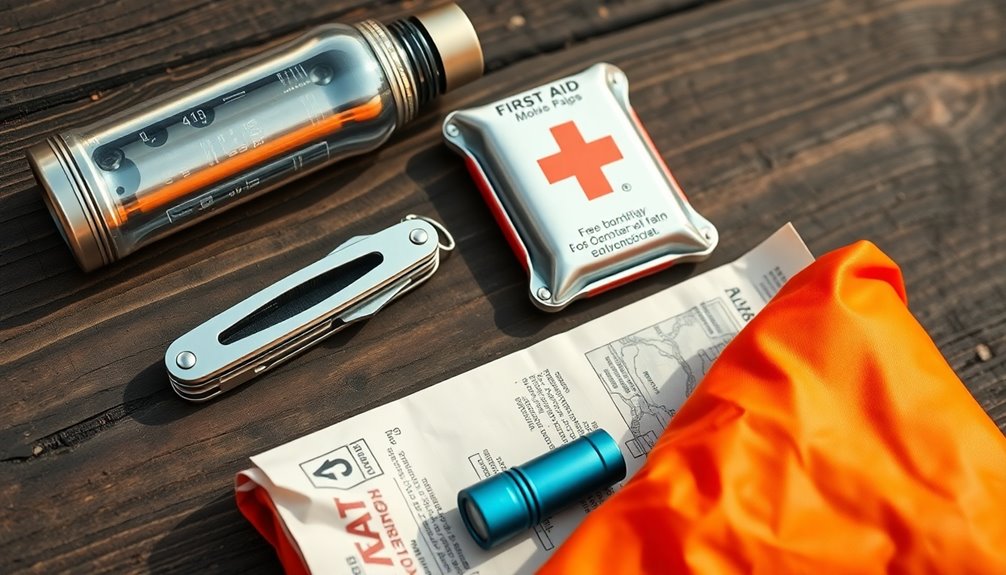
Unexpected emergencies can hit you when you least expect them, making it crucial to prepare ahead of time.
Having a well-stocked survival kit not only prevents costly roadside emergencies but also ensures you're ready for anything that might come your way.
Prevents Costly Roadside Emergencies
Roadside emergencies can catch anyone off guard, but being prepared can make all the difference. A well-packed emergency bag is crucial, as it contains important items needed to sustain you for at least 72 hours.
Include at least one gallon of water per person per day, as dehydration can escalate quickly. Don't forget to pack non-perishable food items that can provide the necessary energy during unexpected situations.
Regular vehicle maintenance can prevent many emergencies, but having an emergency kit ensures you're ready for anything. Familiarize your family with the kit's location and contents, so everyone knows where to find it.
This preparation can significantly reduce panic and help you handle roadside emergencies more effectively.
Contextual Emergency Preparedness Importance
Preparing for emergencies significantly boosts your chances of survival when crises strike. Nearly 48% of Americans lack essential emergency supplies, which can be critical when you need food, water, and shelter.
A well-stocked emergency kit should sustain you and your family for at least 72 hours. Regularly check and update your supplies to prevent food spoilage and ensure your gear works effectively. Everyone in your household should know where the emergency kit is and what's inside, reducing panic during an actual emergency.
Additionally, consider community preparedness by including high-calorie, non-perishable food items and maintaining your vehicle to avoid breakdowns. Your proactive approach to preparedness can make all the difference in unexpected situations. Moreover, understanding the importance of community resilience can help you create a stronger support network during emergencies.
Emergency Kit Maintenance Tips
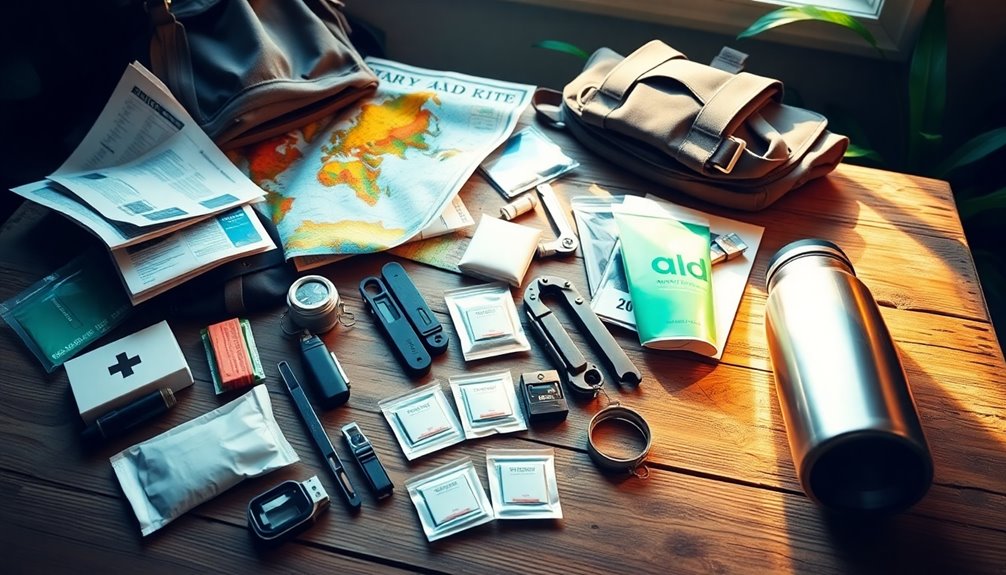
Every six months, take a moment to check your emergency kit and ensure it's ready for action.
Inspect all food and medical supplies to confirm they're functional, fresh, and not expired. Rotate perishable items like food and batteries to prevent spoilage.
Keep a checklist of your emergency kit contents and update it whenever you add or remove items, ensuring you maintain a comprehensive inventory.
Store your kit in an accessible location within your vehicle or home, and make sure every family member knows where it's for quick retrieval during emergencies.
Also, consider seasonal changes—add extra blankets in winter or adjust food items based on potential travel routes and climate conditions.
Stay prepared!
Essential Gear Recommendations
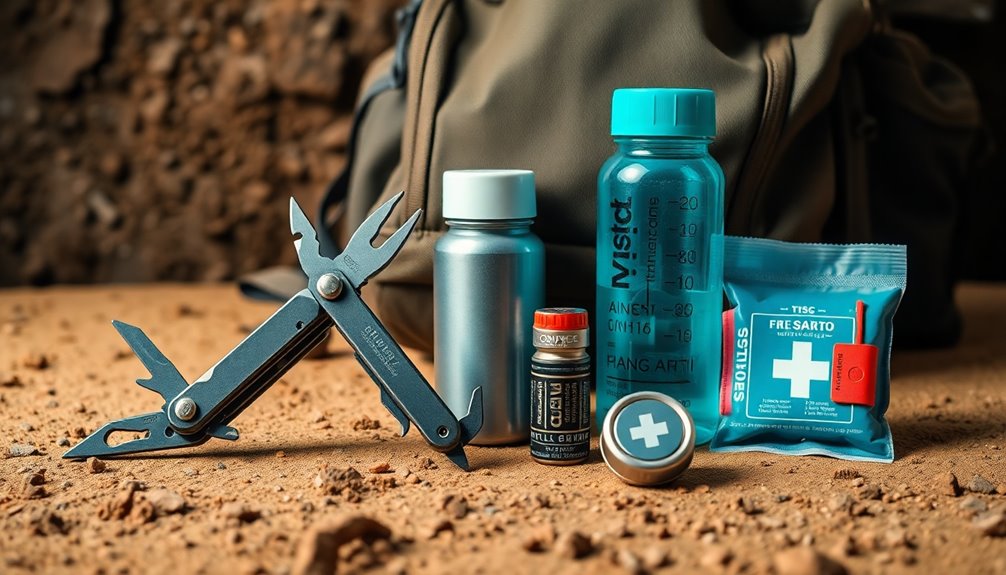
Keeping your emergency kit in top shape is just the start; equipping it with the right gear makes all the difference when disaster strikes.
One essential item is a well-stocked first aid kit, which should include antiseptics, bandages, and pain relievers.
Next, a reliable folding knife is crucial for cutting and preparing food.
Don't forget water purification tablets; they can purify up to 2.5 gallons per ten tablets, ensuring you stay hydrated.
Additionally, pack fire-starting tools like a ferrocerium rod and waterproof matches—having at least three methods will help you create warmth and cook food.
Lastly, a versatile multi-tool combines various tools in one device, perfect for repairs and food preparation.
Including items like sugardine for wound care can also significantly boost your survival odds.
Emergency Kit Organization Tips
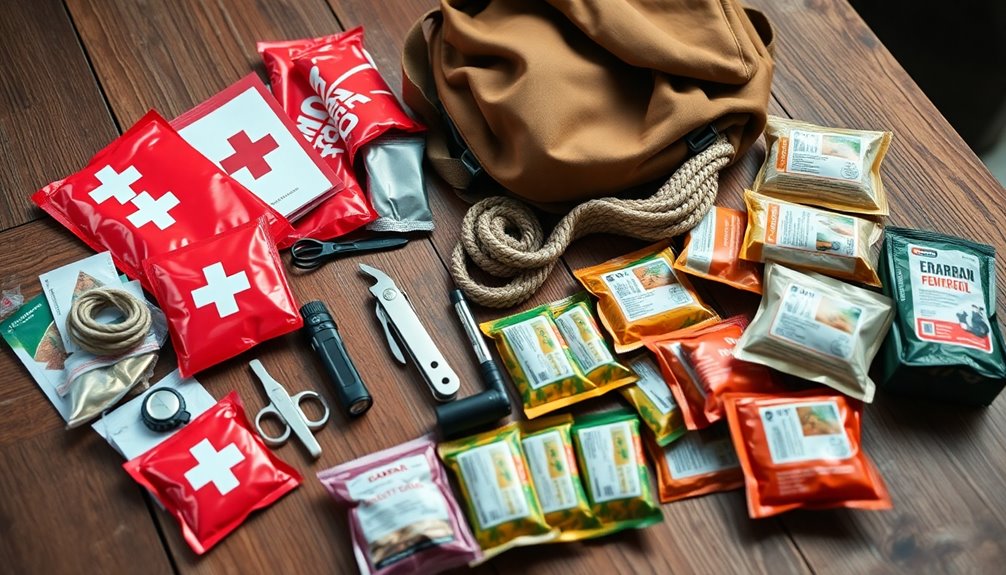
Organizing your emergency kit effectively can make a crucial difference in a crisis. Start by grouping items into categories like sanitation, sustenance, medical supplies, and emergency gear.
Use clear, labeled containers or zip-loc bags to keep similar items together, such as water bottles and non-perishable food. This way, you'll quickly locate essential supplies when needed.
Regularly check your kit and update its contents, rotating food and water supplies every six months to ensure freshness.
Store your emergency kit in a designated, easily accessible location in your home or vehicle, making sure all family members know where to find it.
Lastly, consider the size and weight of your containers to ensure they're transportable during an evacuation.
Organizing for Quick Access
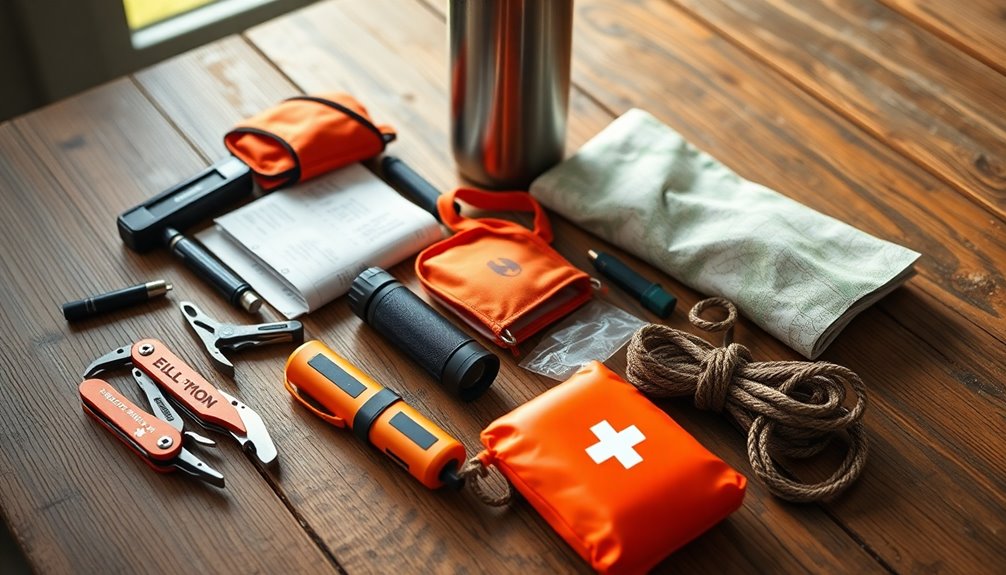
To ensure your survival gear is always ready when you need it, make seasonal item adjustments a priority.
Check expiration dates regularly, so you won't be caught off guard with unusable supplies.
Keeping your gear fresh and relevant not only enhances your preparedness but also boosts your confidence in emergencies.
Seasonal Item Adjustments Advised
As the seasons change, adjusting your survival kit becomes essential for staying prepared.
Seasonal item adjustments not only keep your gear relevant but also enhance your emergency preparedness. Pack warmer clothing and thermal gear for winter, while lightweight clothing is perfect for summer.
Incorporate seasonal tools like ice scrapers and hand warmers for winter, and insect repellent and sunscreen for summer. Additionally, consider including hydration systems to ensure water accessibility during hot months.
It's crucial to regularly check your kit's contents and rotate food and water supplies, focusing on items with a long shelf life.
Organize everything by season using labeled zip-loc bags or containers for quick access.
This way, you'll always be ready to tackle the specific challenges each season brings.
Regularly Check Expiration Dates
Maintaining a well-stocked survival kit means regularly checking expiration dates on all food items and supplies. Even non-perishable items like protein bars and canned goods can spoil or lose nutritional value over time.
To keep your emergency kit effective, rotate supplies every six months, especially medications and perishable food. Create a simple checklist that includes expiration dates for each item in your kit, which streamlines organization and makes it easier to track replacements.
Store items in clearly labeled containers for quick access during emergencies, minimizing wasted time searching for food supplies. Using zip-loc bags or vacuum sealing not only compacts your items but also keeps expiration dates visible, ensuring you're always prepared when it matters most.
Survivor Stories From Roadside Emergencies
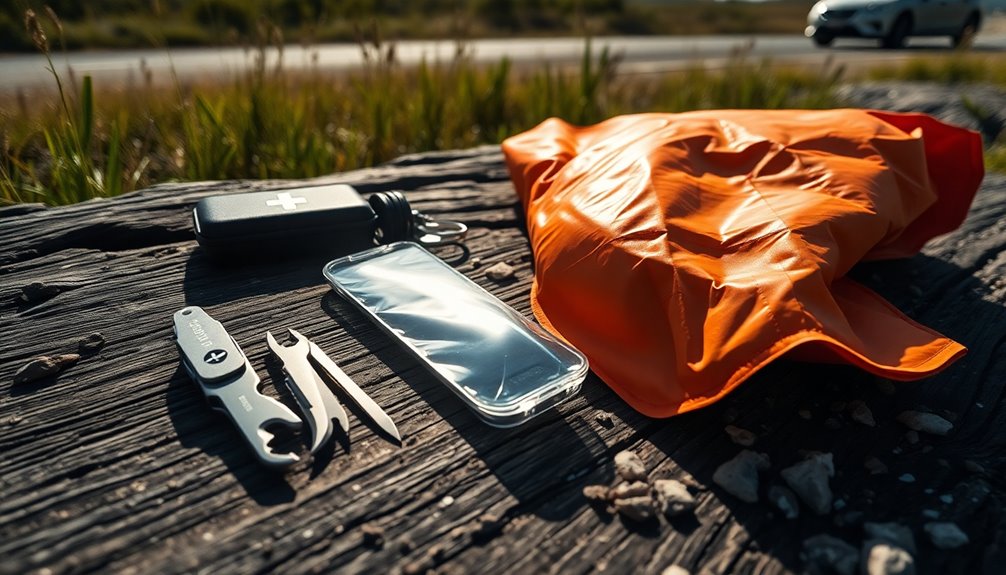
Roadside emergencies can strike out of nowhere, leaving drivers feeling vulnerable and unprepared. You might recall survivor stories of individuals who faced daunting situations, often turning to their emergency kits for support.
A well-stocked kit can sustain you with first aid supplies, emergency blankets, and even water purification tablets, crucial for survival during breakdowns. When trapped in severe weather, having these essentials can make a world of difference.
Don't underestimate the importance of your cell phone; it can be your lifeline in calling for help. However, remember that nearly 25% of motorists lose cell service in rural areas, so being prepared with knowledge and supplies is vital.
Stay equipped, and you'll boost your chances of emerging from roadside emergencies unscathed.
Conclusion
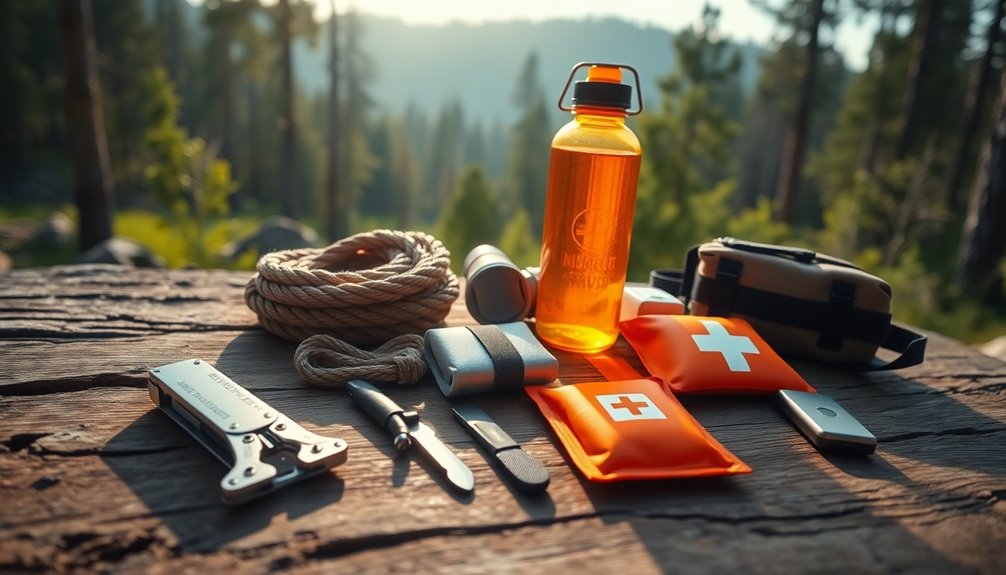
Preparedness can mean the difference between panic and calm during unexpected roadside emergencies.
As you create your survival kit, focus on essential items like a comprehensive first aid kit, water purification tablets, and a reliable multi-tool. Regularly update your supplies to ensure everything remains fresh and functional.
Prioritize lightweight gear that's easy to transport, such as portable water filters and fire-starting tools, to maximize your efficiency.
Don't overlook the importance of navigation tools, like a compass and maps, which can significantly improve your chances of finding help.
Tailor your checklist to your specific location and personal needs, ensuring you're ready for anything.
With the right preparation, you'll face emergencies with confidence, knowing you're equipped to handle them effectively.
Additional Resources
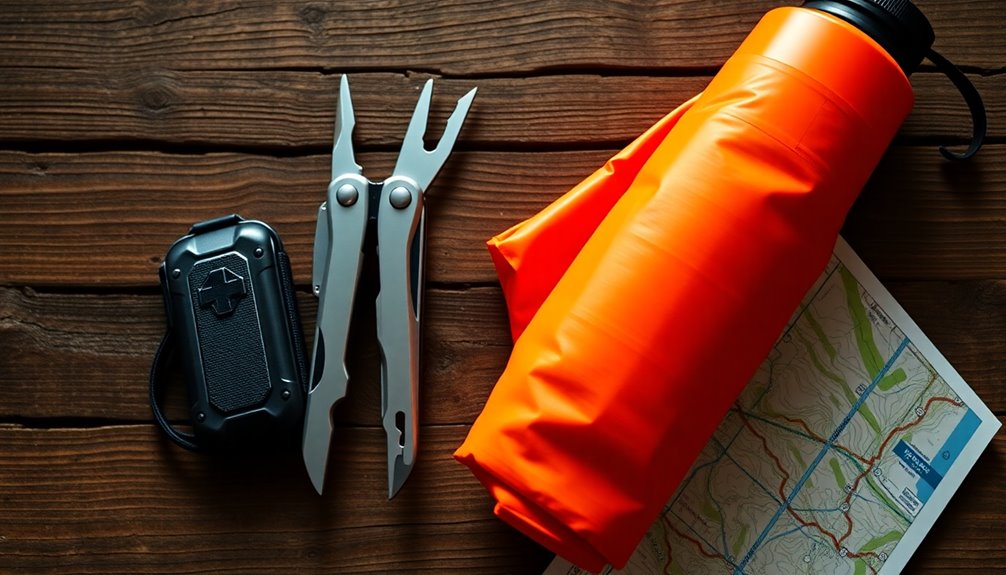
To enhance your survival skills and knowledge, consider tapping into a variety of resources that can provide valuable insights and practical tips.
Start by downloading comprehensive PDF versions of survival checklists tailored for different environments and emergencies, making them easy to reference when needed.
Engage with online survival forums to gather personal experiences from seasoned survivalists, enriching your preparedness strategies.
Instructional videos on platforms like YouTube can guide you in using and packing survival gear effectively.
Don't forget to access mobile apps offering survival tips, first aid instructions, and offline maps for emergency response when you're disconnected.
Lastly, regularly review and update your survival checklist based on seasonal changes and advancements in survival gear to stay always prepared.
Frequently Asked Questions
What Are the 10 Essential Survival Kit Items?
When you're putting together a survival kit, you need to include a versatile knife, a reliable fire starter, and a durable water bottle.
Don't forget water purification tablets for safe drinking. A compact first aid kit is crucial for treating injuries.
Pack non-perishable food items like energy bars, a flashlight with extra batteries, and signaling devices like whistles.
Lastly, a sturdy multi-tool can help you tackle various tasks when you're in the wild.
What Are the 5 Most Important Survival Items?
When you're thinking about the most important survival items, consider a reliable knife, as it's incredibly versatile for tasks like cutting and shelter building.
Don't forget water purification tablets; staying hydrated is crucial.
A fire starter is essential for warmth and cooking, while a well-stocked first aid kit helps you manage injuries.
Lastly, a durable water bottle is key for carrying and purifying water, ensuring you stay healthy in any situation.
What Are 10 Items in an Emergency Go Bag?
When packing an emergency go bag, think about essentials that'll keep you safe and prepared.
Include a comprehensive first aid kit, water purification tablets, and a durable water bottle.
Don't forget a reliable multi-tool and non-perishable food items like protein bars.
A flashlight with extra batteries is crucial for visibility, while a whistle can help with signaling.
Lastly, pack a warm blanket and a map to navigate if necessary.
What Are at Least 10 Items Clearly Necessary for Survival During or After a Disaster?
When you're preparing for potential disasters, certain items are clearly necessary for survival.
You'll need a reliable water purification method to ensure safe drinking water. A multi-tool or knife is essential for various tasks, while fire-starting tools help with warmth and cooking.
Don't forget non-perishable food for energy, a first aid kit for injuries, a flashlight for visibility, a whistle to signal for help, sturdy clothing, and a map for navigation.

